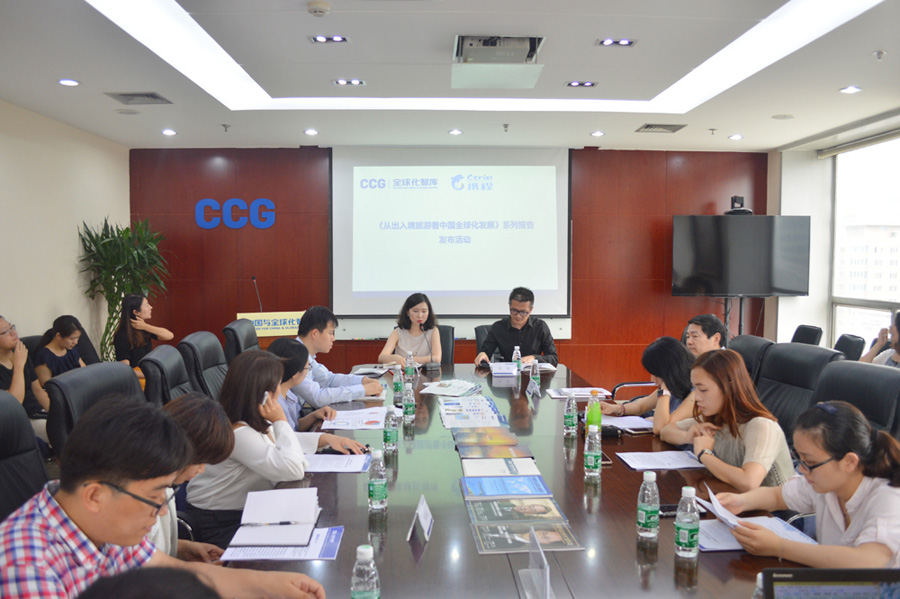Efforts in dire need to woo international arrivals given the growing tourist deficit
May 27 , 2019In association with Ctrip, CCG issues a report about “Globalization and China’s inbound & outbound tourism” as one of such series in Beijing on July 5, 2017.
Abundant of data are used to illustrate the status quo of the global tourism and the situation of inbound and outbound tourism. According to the report, the international arrivals increase sluggishly during the past decade especially comparing with the booming outbound Chinese tourists and thus the tourist deficit get worse over time.

Miao Lu, vice president and general-secretary of CCG, and Sun Bo, senior deputy president, attend the conference and deliver their speeches. Li Qing, the vice director of Research department of CCG, chairs the press conference.
With the development of globalization and new technologies, international tourism grows dramatically. According to the report, the tourism contributes to the 10 percent of the global GDP and 10 percent of the jobs of the world. Besides, the growth rates of the global tourist revenue have been overtaking those of world economic growth in the past six straight years.
Chinese tourists become popular around the world due to their massive numbers and strong consumption power.
Chinese overseas tourists from mainland account for 10 percent of all international travelers in 2016 which makes China one of the tourist powers.
Despite the depressed world economy, the amount of the consumption for the mainland travelers has increased at double-digit speed for past 12 consecutive years.
The amount of consumption for mainlanders is about $261 billion which makes up 20.9% of the annual tourist spending of the world. That also explains why more and more countries are facilitating tourist visa systems to Chinese travelers.
Comparing with outbound tourists, the inbound international travelers see a lukewarm growth. From 2005 to 2015, the number of the outbound mainland tourists has swollen up 312.9 percent while that number of inbound tourists only increases by 11.2 percent. The growth is far lower than the average 81.3 percent in the Asian-Pacific region and also less than the 38.9 percent of developed countries and 57.2 percent of emerging economies.
China saw 30 million of tourist trip deficit in 2015 as Chinese outbound trips reached up to 57.62 million while only 25.98 millions of foreign trips came over to China.
International tourists are part of flow of global talents which also stands for the globalization. Attracting foreign tourists could be an important approach to upgrade national image and soft power.
As the second largest economy with long and splendid history, China ought to improve its tourist attractiveness to match up to its economic development and world influence.
The key points of the report are as follows:
1.Tourism has turned to be one pillar industry based on the double 10 percent ratios
According to the data in the report, the whole revenue of the global tourism reached $7.6 trillion in 2016 and the industry also provided 292 millions of jobs which accounts for 10 percent of the whole posts of the world. In 2015, the tourist revenue constitutes up to 10 percent of the global GDP.
- Asian Pacific has surpassed Americas in terms of the number of international visitors, and become a new engine for global tourism industry.
According to the report, international tourist arrivals in emerging economies have increased from 136 million in 1990 to 533 million in 2015. Meanwhile, their share in the global total also grew from 31.26% to 44.94%. Among all continents, Europe remains the top destination for international tourists, followed by Asia Pacific and Americas. Prior to 2005, Americas has been holding the second place but was eventually surpassed by the emerging economies in Asia Pacific.
- All the countries are making effort to attract Chinese tourists, whose overseas spending ranks the No.1 in the world.
According to the report, along with growing national economy and improving living condition, Chinese tourists are becoming more in favor of international destinations and overseas consumption. In 2015, outbound Chinese tourists amounted to 128 million, increased by 9.4% from 2014, which accounted for more than 10% of the global total, making China the largest source of international tourists. As President Xi forecast at the Davos Economic Forum in 2017, China’s outbound tourists will reach 700 million in the next five years.
In the meantime, China is driving world tourism economy through rapidly growing overseas spending, which has reached US$ 261 billion in 2016 and accounted for 20.9% of the global total tourism consumption. Based on MOFCOM’s statistics, half of Chinese tourists’ overseas spending went to shopping and have significantly benefited tourism destination countries, especially Japan, Republic of Korea and Thailand.
- Belt and Road countries are gaining popularity among Chinese outbound tourists
Among all the tourism destinations overseas, Hong Kong, Macau and Taiwan remain the top choices because of their proximity, cultural connection and accessibility for mainland Chinese tourists. The top 10 international destinations are Thailand, ROK, Japan, USA, Singapore, Vietnam, Malaysia, Indonesia, Russia and Australia. Thanks to the Belt and Road Initiative, the countries and regions along the routes in Central and East Europe, Central Asia and South Asia are gaining popularity among Chinese tourists.
Geographically, the top 10 sources of Chinese outbound tourists are Beijing, Shanghai, Guangdong, Jiangsu, Zhejiang, Tianjin, Shandong, Liaoning, Fujian and Hubei.
- Foreign countries have reformed visa application and approval polices to attractChinese outbound tourists.
According to the official statistics from the Bureau of Exit and Entry Administration of the Ministry of Public Security, as of March, 2017, up to 130 countries and regions have signed visa exemption agreements with China. Other incentives include lowering visa application requirement, extending period of visa validity and reducing visa application fee. Some countries, such as USA, Canada, Australia, Singapore, ROK, Israel and Argentine, even created special visa process procedure for Chinese applicants.
- The growth rate of the inbound tourists to China is lower than the average level in Asia Pacific, and China is facing widening tourism deficit.
Compared to the rapid growth of China outbound tourism, inbound tourism’s rise is rather lackluster. The data from the State Statistics Bureau show the number of inbound tourists in China increased from 12,029 in 2005 to 13,382 in 2015, a compound growth rate of 11.2% during the 11 years, or averagely 1% per year, which is a stark contrast to the 312.9% growth in outbound tourists during the same period. Based on the current situation, it is expected that the tourism deficit will be further widened and may hit 100 million in the next five years.
The tourism deficit has led to a big shortfall of foreign currency income. In 2016, the foreign currency income from inbound tourists in China reached US$120 billion, only 5.6% higher than 2015. Transportation is the biggest contributor, accounting for 39.46% of the total, while the consumption of foreign tourists is only 1/5 of Chinese outbound tourists’ spending abroad.
- The rising demand of Chinese outbound tourists requires more internationalized services
Chinese outbound tourists require more tailored, professional and internationalized services, as they are gaining more experience and knowledge of traveling abroad. However, from the supply side, most tourist products are marketed and provided through domestic channels that are faulted with illegal and inappropriate practice as well as unfair competition. More regulatory effort and industrial policies are needed to match the supply of tourism services with the rising market demand.
- The international tourism supply chain needs to improve to reduce China’s tourism deficit.
The report provides an analysis of the factors that cause China’s tourism deficit, such as the lack of tourism destination promotion abroad, too many unnecessary restrictions on foreign visitors’ visa application, and China’s tourism service falling behind international standards.






